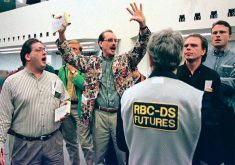Livestock producers drowning in red ink from high costs and reduced meat demand hoped that when the country’s agriculture ministers met recently, they’d throw them a lifeline. Instead, ministers agreed to launch a mandatory livestock and poultry traceability program rife with costs and technological complexities and without any quick payback for the livestock industry.
Mandatory traceability is the right goal for the industry in the long term, but federal agriculture minister Gerry Ritz and his provincial counterparts want to get it done in a hurry, by 2011.They argue that after a good start on two of the three legs of traceability, animal and premise identification, Canada is now falling behind competitors such as Australia and Argentina and customers are wondering when Canada will catch up.
Read Also

Kochia has become a significant problem for Prairie farmers
As you travel through southern Saskatchewan and Alberta, particularly in areas challenged by dry growing conditions, the magnitude of the kochia problem is easy to see.
So the ministers, with the exception of Saskatchewan’s Bob Bjornerud, want to fast track a mandatory system that will track animals from their place of birth through auction markets to feedlots and on to packing plants. This would, in the case of something like a disease outbreak, provide the rapid identification of animals, their herd of origin and ownership, potentially limiting spread of the disease and the detrimental effects on markets.
It sounds good and Canada’s livestock associations have worked on developing a system but that investigation has shown it would have serious complexities and costs.In cattle for example, identification is based on radio frequency ear tags. Each auction market, backgrounder, feedlot and packer, small or large, will need the equipment that reads the tags and the computers to store the information and transmit it to a central data base. The technology must work without impeding the speed of business and protocols must be written to account for the fact that the tags are not perfect, some fall off or break.
The system must be verifiable so that claims arising from it are true.
Producers and others in the system need education on how the technology works and how to handle and benefit from the information it produces.
This takes time and it is a good idea to renew the effort with a greater sense of purpose, but a deadline of 2011 for a mandatory program implies a workable system will be in place. That is a big assumption and because mandatory programs must be enforced, producers and others in the system might face penalties for not complying with a faulty program.
There is no need for haste. Meat importers might desire a traceability system, but none require it and are unlikely to until the world’s biggest meat exporter, the United States, would be able to comply. U.S. progress toward traceability is far behind Canada’s and, given the opposition to this type of mandatory program there, it will be a long time, if ever, before they are ready.
Few global buyers of meat would be willing to demand measures that would cut themselves off completely from American supply. For now, traceability is a marketing advantage, not prerequisite. Canada must work hard to seize this advantage, but needs time to create a market leading program producing clear benefits that producers can buy into.
Bruce Dyck, Terry Fries, Barb Glen, D’Arce McMillan and Ken Zacharias collaborate in the writing of Western Producer editorials.
















